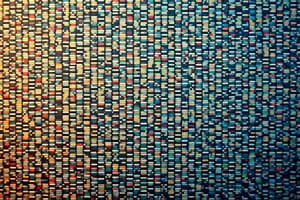Podcast
Questions and Answers
What is the purpose of using 11 different probes for each gene on a microarray?
What is the purpose of using 11 different probes for each gene on a microarray?
- To obtain a more accurate average expression value (correct)
- To improve the speed of the experiment
- To reduce the number of genes analyzed
- To increase the chance of inaccurate readings
Microarray technology relies solely on one type of probe for gene expression analysis.
Microarray technology relies solely on one type of probe for gene expression analysis.
False (B)
What method is used in microarrays to compare expression levels of different samples?
What method is used in microarrays to compare expression levels of different samples?
Two color fluorescence
To reduce binding noise in microarrays, probe sets for a single gene are ______ across the GeneChip.
To reduce binding noise in microarrays, probe sets for a single gene are ______ across the GeneChip.
Match the microarray application with its purpose:
Match the microarray application with its purpose:
What is the primary purpose of a microarray?
What is the primary purpose of a microarray?
The transcriptome consists of all an organism's genes.
The transcriptome consists of all an organism's genes.
What does the term 'central dogma' refer to?
What does the term 'central dogma' refer to?
Microarrays rely on the biological principle of __________ hybridisation.
Microarrays rely on the biological principle of __________ hybridisation.
Match the term to its definition:
Match the term to its definition:
Which statement best describes the transcriptome?
Which statement best describes the transcriptome?
Probes used in microarrays are complementary to known mRNA sequences of genes.
Probes used in microarrays are complementary to known mRNA sequences of genes.
What must be known in order to use microarrays effectively?
What must be known in order to use microarrays effectively?
What is the primary function of the probes used in microarrays?
What is the primary function of the probes used in microarrays?
The microarray process requires knowledge of gene sequences prior to detection.
The microarray process requires knowledge of gene sequences prior to detection.
What is used to convert mRNA from the test sample into cDNA?
What is used to convert mRNA from the test sample into cDNA?
The ___ of fluorescence detected by a chip reader indicates the level of gene expression.
The ___ of fluorescence detected by a chip reader indicates the level of gene expression.
Which type of platform synthesizes short oligonucleotides on a silicon base?
Which type of platform synthesizes short oligonucleotides on a silicon base?
Fluorescent probes are labeled and applied to the microarray to facilitate gene identification.
Fluorescent probes are labeled and applied to the microarray to facilitate gene identification.
Match the following components of the microarray process with their descriptions:
Match the following components of the microarray process with their descriptions:
Short oligonucleotides are typically ___ to ___ nucleotides long in microarray technology.
Short oligonucleotides are typically ___ to ___ nucleotides long in microarray technology.
Flashcards are hidden until you start studying
Study Notes
Central Dogma of Molecular Biology
- Central Dogma framework: DNA (genome) → RNA (transcriptome) → Protein (proteome).
- Genome encompasses all genes and regulatory DNA sequences.
- Transcriptome refers to the complete array of transcripts in a specific tissue or cell at a given time.
- Transcriptomes are dynamic; they vary by tissue function while the genome remains constant.
Microarrays Overview
- Microarrays are tools designed to measure gene expression levels of thousands of genes simultaneously.
- They assess actively expressed genes through mRNA present in the sample via complementary hybridization.
- Requires prior knowledge of target mRNA sequences for effective probe design.
Microarray Process
- Probes (25-70 nucleotides) are synthesized to match known mRNAs and immobilized on solid surfaces like silicon.
- mRNA from a sample is converted to cDNA using reverse transcriptase and labeled with fluorescent probes.
- Labeled cDNA hybridizes to the microarray, indicating which genes are expressed based on fluorescent signal detection.
- A laser scans the array; fluorescent tags produce signals indicating expression levels for specific genes.
Types of Microarray Platforms
- Affymetrix GeneChips feature multiple short oligonucleotides (25mers) allowing up to 40,000 gene targets per chip with single-channel fluorescence.
- Each gene is represented by multiple probes (11 probes per gene) to minimize cross-hybridization errors.
- Spotted cDNA or long oligos (70mers) can be used on glass slides for two-channel simultaneous comparison of samples.
Importance of Controls and Statistical Analysis
- The risk of multiple gene probes binding due to sequence similarity necessitates random probe distribution across the chip.
- Probes are carefully designed to reduce noise and inaccuracies in expression readings.
- Scanner outputs expression values for each gene based on fluorescent intensity and location.
Applications of Microarrays
- Identification of regionally expressed genes.
- Coregulation studies, such as monitoring gene expression during different cell cycle phases (G1, S, G2, M).
- Comparative analysis using differently colored labels for simultaneous expression comparison across samples.
- Graphical representation of comparative expression can reveal similarities or differences in gene expression levels.
Key Takeaways
- Microarrays provide insights into large-scale gene regulation.
- Understanding the principles of complementary hybridization is crucial for effective application.
- Proper controls and statistical analysis enhance the reliability of data obtained from microarray experiments.
Studying That Suits You
Use AI to generate personalized quizzes and flashcards to suit your learning preferences.




